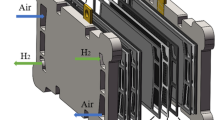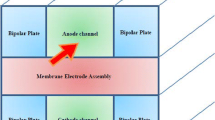Abstract
Power characteristics are important indicators of fuel cell performance. In the actual operation of fuel cells, changes in operating conditions lead to variations in their power characteristics. Therefore, it is imperative to explore the impact of operating conditions on power characteristics. This paper analyzes the factors influencing fuel cell power and uses sensitivity analysis to investigate how different factors affect fuel cell performance. The operating parameters are optimized using a Bayesian-optimized Gaussian process regression model. The research results indicate that temperature has the greatest impact on fuel cell power, followed by stoichiometry and backpressure. The Bayesian-optimized Gaussian process regression model performs the best, reducing its RSME from 0.1 to 0.0556. Residual analysis and regression characteristic analysis verify the optimized model's improved fitting and regression characteristics. Based on the Bayesian–Gaussian process regression model, the optimized operating parameters are obtained for maximum power: a temperature of 80 °C, stoichiometry of 4, and backpressure of 1.7 bar. This paper provides theoretical support for improving fuel cell performance.
Graphical Abstract










Similar content being viewed by others
Availability of data and materials
All data, models, and code generated or used during the study appear in the submitted article.
References
Mekhilef S, Saidur R, Safari A (2012) Comparative study of different fuel cell technologies. Renew Sustain Energy Rev 16(1):981–989
Sazali N, Wan Salleh WN, Jamaludin AS et al (2020) New perspectives on fuel cell technology: a brief review. Membranes 10(5):99
Daud WRW, Rosli RE, Majlan EH et al (2017) PEM fuel cell system control: a review. Renew Energy 113:620–638
Kim YB (2010) Improving dynamic performance of proton-exchange membrane fuel cell system using time delay control. J Power Sources 195(19):6329–6341
Wu D, Peng C, Yin C et al (2020) Review of system integration and control of proton exchange membrane fuel cells. Electrochem Energy Rev 3:466–505
Oono Y, Fukuda T, Sounai A et al (2010) Influence of operating temperature on cell performance and endurance of high temperature proton exchange membrane fuel cells. J Power Sources 195(4):1007–1014
Noorkami M, Robinson JB, Meyer Q et al (2014) Effect of temperature uncertainty on polymer electrolyte fuel cell performance. Int J Hydrogen Energy 39(3):1439–1448
Gadkari S, Fontmorin JM, Yu E et al (2020) Influence of temperature and other system parameters on microbial fuel cell performance: numerical and experimental investigation. Chem Eng J 388:124176
Ouaidat G, Cherouat A, Kouta R et al (2020) Numerical modeling of the mechanical behavior of proton exchange membrane fuel cell performance: design of experiment study and optimization. Int J Hydrogen Energy 45(46):25210–25226
Ali EM, Boopathi A M, Abudhahir A et al (2020) Enhancement of PEM fuel cell performance with direct active fuzzy sliding mode controller. In: 2020 Advances in science and engineering technology international conferences (ASET). IEEE, pp 1–6
Kakizawa Y, Schreiber CL, Takamuku S et al (2021) Visualization of the oxygen partial pressure in a proton exchange membrane fuel cell during cell operation with low oxygen concentrations. J Power Sources 483:229193
Shen J, Tu Z, Chan SH (2020) Performance enhancement in a proton exchange membrane fuel cell with a novel 3D flow field. Appl Therm Eng 164:114464
Huang F, Qiu D, Lan S et al (2020) Performance evaluation of commercial-size proton exchange membrane fuel cell stacks considering air flow distribution in the manifold. Energy Convers Manage 203:112256
Abraham BP, Murugavel KK (2021) Influence of catalyst layer and gas diffusion layer porosity in proton exchange membrane fuel cell performance. Electrochim Acta 389:138793
Zhou K, Li T, Han Y et al (2021) Optimizing the hydrophobicity of GDL to improve the fuel cell performance. RSC Adv 11(4):2010–2019
Fu X, Wen Q, Han J et al (2022) One-step to prepare high-performance gas diffusion layer (GDL) with three different functional layers for proton exchange membrane fuel cells (PEMFCs). Int J Hydrogen Energy 47(61):25769–25779
Margalida G, Joseph P, Roussette O et al (2020) Comparison and sensibility analysis of warning parameters for rotating stall detection in an axial compressor. Int J Turbomach Propul Power 5(3):16
Guo Y, Liu M, Yin M et al (2022) Reliability sensibility analysis of the PCB assembly concerning warpage during the reflow soldering process. Mathematics 10(17):3055
Sremakaew M, Konghakote S, Uthaikhup S (2023) A cluster analysis of cervicocephalic kinesthetic sensibility in persons with nonspecific neck pain. Physiother Theory Pract. https://doi.org/10.1080/09593985.2023.2229422
Heysiattalab S, Shakeri M, Safari M et al (2011) Investigation of key parameters influence on performance of direct ethanol fuel cell (DEFC). J Ind Eng Chem 17(4):727–729
Liu Z, Zeng X, Ge Y et al (2017) Multi-objective optimization of operating conditions and channel structure for a proton exchange membrane fuel cell. Int J Heat Mass Transf 111:289–298
Han IS, Park SK, Chung CB (2016) Modeling and operation optimization of a proton exchange membrane fuel cell system for maximum efficiency. Energy Convers Manage 113:52–65
Pei P, Fu X, Zhu Z et al (2022) Activation of polymer electrolyte membrane fuel cells: mechanisms, procedures, and evaluation. Int J Hydrogen Energy 47(59):24897–24915
Christmann K, Friedrich KA, Zamel N (2021) Activation mechanisms in the catalyst coated membrane of PEM fuel cells. Prog Energy Combust Sci 85:100924
Van Der Linden F, Pahon E, Morando S et al (2023) A review on the proton-exchange membrane fuel cell break-in physical principles, activation procedures, and characterization methods. J Power Sources 575:233168
Deng H, Hu W, Cao D et al (2022) Degradation trajectories prognosis for PEM fuel cell systems based on Gaussian process regression. Energy 244:122569
Wang T, Zhou H, Zhu C (2022) A short-term and long-term prognostic method for PEM fuel cells based on Gaussian process regression. Energies 15(13):4844
He YJ, Ma ZF (2016) A data-driven Gaussian process regression model for two-chamber microbial fuel cells. Fuel Cells 16(3):365–376
Wu Y, Zhao H, Zhang C et al (2018) Optimization analysis of structure parameters of steam ejector based on CFD and orthogonal test. Energy 151:79–93
Xia S, Lin R, Cui X et al (2016) The application of orthogonal test method in the parameters optimization of PEMFC under steady working condition. Int J Hydrogen Energy 41(26):11380–11390
Zhang Z, Fang H, Yan H et al (2015) Influencing factors of GaN growth uniformity through orthogonal test analysis. Appl Therm Eng 91:53–61
Funding
There is no funding source.
Author information
Authors and Affiliations
Contributions
X. L. wrote the main manuscript text and C.P. and J.S. checked the grammar of the manuscript. All authors reviewed the manuscript.
Corresponding authors
Ethics declarations
Conflict of interest
The authors declare no competing interests.
Ethical approval
This article does not contain any studies with human participants or animals performed by any of the authors.
Additional information
Publisher's Note
Springer Nature remains neutral with regard to jurisdictional claims in published maps and institutional affiliations.
Rights and permissions
Springer Nature or its licensor (e.g. a society or other partner) holds exclusive rights to this article under a publishing agreement with the author(s) or other rightsholder(s); author self-archiving of the accepted manuscript version of this article is solely governed by the terms of such publishing agreement and applicable law.
About this article
Cite this article
Liao, X., Photong, C. & Su, J. Sensitivity analysis and optimization of operating conditions of proton exchange membrane fuel cell. J Appl Electrochem (2024). https://doi.org/10.1007/s10800-024-02130-y
Received:
Accepted:
Published:
DOI: https://doi.org/10.1007/s10800-024-02130-y




